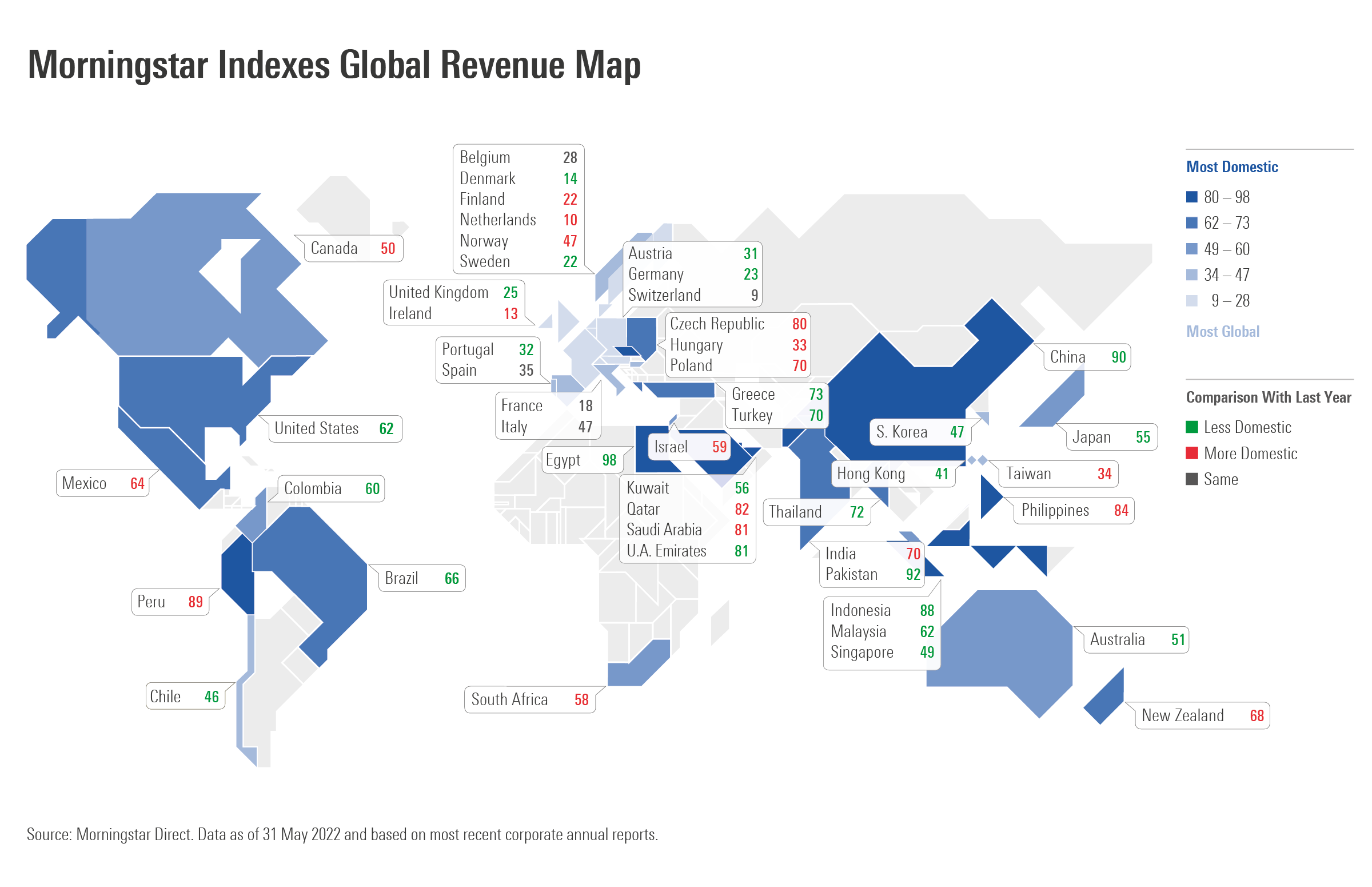
Most Asian equity markets have globalized, according to new research from Morningstar’s Index group. Japan, China, South Korea, Hong Kong, and Singapore all derive more revenue internationally than they did last year.
Asia is part of a global trend. Of the 48 national equity markets that Morningstar tracks through its indices, which span the Asia Pacific Region, Europe, and the Americas, only 18 have become more domestically focused. The Japanese stock market currently derives 45% of revenues from outside of Japan, compared with 43% when the data was examined in June 2021; China went from 9% international to 10%, South Korea from 52% international to 53%; Hong Kong from 59% international to 58%; and Singapore from 50% international to 51%.
Deepening globalization runs contrary to the dominant current narrative. We live in a “postglobal world,” according to the title of a new book describing a trend toward “localization.” A recent issue of The Economist focuses on “Reinventing Globalisation.” “Offshoring,” popular in the 1990s and 2000s, has become a dirty word, while “onshoring,” “reshoring,” and “slowablization” are trending. Even before the pandemic, inflation, and war in Europe exposed the weaknesses in global supply chains, political currents had turned against globalization. Independence and self-sufficiency are ascendant.

Pursuing Revenue Streams Across Borders
To understand what’s going on, remember the truism that stock markets are markets of stocks. Market-level trends are driven by the behavior of their underlying businesses. Consider Keyence, a Japanese manufacturer of electronic equipment, whose revenues from outside Japan, including China and the U.S., grew by more than its domestic revenue, contributing to the Japanese market's globalization.
Emerging Markets Remain the Most Domestic, Europe the Most Outward-Looking
The world’s four largest equity markets—the U.S., Japan, the United Kingdom, and China—all source a larger share of revenue internationally than they did last year. None of the moves were dramatic. Japan went from 57% domestic a year ago to 55% this year. The U.K. went from 27% to 25%, and China from 91% to 90%.
Emerging markets, such as Egypt, Pakistan, China, Peru, Indonesia, the Philippines, and Persian Gulf states, remain the most domestically oriented. The fact that the Morningstar China Index sources an estimated 90% of revenue from China, despite the Chinese economy’s export orientation, can be explained by the domestic focus of its top constituents Tencent TCEHY, Alibaba BABA, Meituan MPNGY, China Construction Bank CICHY, and JD.com JD.
European markets remain the world’s most outward-looking. With the exception of Greece, which is largely domestic, European markets are dominated by global companies. The Morningstar Switzerland Index, which includes Nestle NSRGF, Roche RHHBY, and Novartis NVS, is the most global, with the U.S. representing an estimated 30% of its revenues. Amazingly, the Morningstar Netherlands Index sources more revenue from Taiwan (an estimated 13%) than from the Netherlands (10%). It’s less surprising to see countries with small populations like Ireland and Denmark among the world’s outward-oriented, than it is for larger economies like France, Germany, and the U.K. Other European countries are the largest sources of revenue for the Morningstar Europe Index, followed by the U.S. (an estimated 22%) and China (9%).
Economic sectors do not seem to be strong drivers of change from last year. Sectors differ significantly in terms of geographic focus. The technology sector is the most global, while utilities, real estate, and financials are the most domestic. But some resources-heavy markets became more global, including Australia, Brazil, Chile, and the United Arab Emirates; but others, like Canada, Peru, Saudi Arabia, Norway, South Africa, and Qatar did not. The market for resources is obviously global, so producers might be expected to increase international revenues in an era of high prices and soaring demand. Similarly, some technology-heavy markets, including the U.S. and South Korea, globalized, while others like Taiwan and India, did not.
Revenue Sources Blur the Lines Between Domestic and Foreign
The fact that equity markets are globalizing certainly runs counter to the narrative that supply chains are onshoring and countries are pursuing self-sufficiency. But the stock market is not the economy. Revenue sources for public companies represent just a piece of the mosaic. There are many other ways to measure economic globalization—the most common being trade as a percentage of gross domestic product.
For investors, globalized revenue sources blur the lines between the domestic and international portions of a portfolio. While it’s true that global exposure can often come through domestic companies, it’s also true that leading players in an investor’s home market may be based offshore. As ever, a global portfolio offers the broadest opportunity set.












.png)








